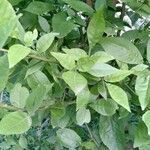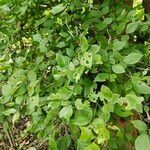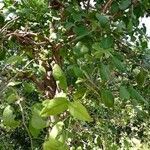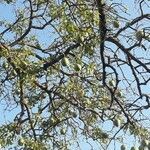| Therapeutic use
|
Abdominal pain (bark), Anthelmintics (bark), Antipyretics (bark), Depressive disorder (bark), Diarrhea (bark), Dysentery (bark), Fever (bark), Gastrointestinal diseases (bark), Headache (bark), Heart diseases (bark), Hypoglycemic agents (bark), Parasympatholytics (bark), Snake bites (bark), Abdominal swelling (bark), Abscess (bark), Hair loss (bark), Anti-bacterial agents (bark), Anti-inflammatory agents (bark), Antipruritics (bark), Appetite stimulants (bark), Asthma (bark), Bronchitis (bark), Calculi (bark), Cardiotonic agents (bark), Contraceptive agents (bark), Cough (bark), Demulcents (bark), Diabetes mellitus (bark), Diphtheria (bark), Diuretics (bark), Dracunculiasis (bark), Dyspepsia (bark), Dysuria (bark), Edema (bark), Epididymitis (bark), Expectorants (bark), Fatigue (bark), Flatulence (bark), Gout (bark), Helminthiasis (bark), Inflammation (bark), Intestinal diseases, parasitic (bark), Irritable bowel syndrome (bark), Kidney calculi (bark), Kidney diseases (bark), Labor pain (bark), Laxatives (bark), Lithiasis (bark), Liver diseases (bark), Neoplasms (bark), Pectoralis muscles (bark), Pharyngitis (bark), Postnatal care (bark), Pregnancy complications (bark), General tonic for rejuvenation (bark), Skin diseases (bark), Spasm (bark), Stomach diseases (bark), Hydrocele (bark), Tuberculosis, lymph node (bark), Urinary bladder calculi (bark), Urinary bladder diseases (bark), Urinary tract infections (bark), Urination disorders (bark), Urolithiasis (bark), Vomiting (bark), Wounds and injuries (bark), Antiperiodic (bark), Antiemetics (flower), Diarrhea (flower), Astringents (flower), Cholagogues and choleretics (flower), Abdominal pain (fruit), Anthelmintics (fruit), Anti-infective agents, local (fruit), Anti-obesity agents (fruit), Antipyretics (fruit), Antirheumatic agents (fruit), Antiviral agents (fruit), Appetite stimulants (fruit), Astringents (fruit), Brain diseases (fruit), Colic (fruit), Constipation (fruit), Demulcents (fruit), Diabetes mellitus (fruit), Diarrhea (fruit), Diet, food, and nutrition (fruit), Digestive system diseases (fruit), Dysentery (fruit), Dyspepsia (fruit), Dysuria (fruit), Edema (fruit), Fever (fruit), Gastrointestinal diseases (fruit), Genital diseases, female (fruit), Hair diseases (fruit), Headache (fruit), Hemorrhoids (fruit), Hyperglycemia (fruit), Hypoglycemic agents (fruit), Hysteria (fruit), Jaundice (fruit), Laxatives (fruit), Nervous system diseases (fruit), Neurotic disorders (fruit), Increase physical endurance, strength and stamina (fruit), Pneumonia (fruit), General tonic for rejuvenation (fruit), Sinusitis (fruit), Spasm (fruit), Toothache (fruit), Tuberculosis (fruit), Urination disorders (fruit), Vomiting (fruit), Child health (fruit), Malabsorption syndromes (fruit), Cooling effect on body (fruit), Abscess (leaf), Hair loss (leaf), Analgesics (leaf), Anthelmintics (leaf), Anti-arrhythmia agents (leaf), Anti-bacterial agents (leaf), Antifungal agents (leaf), Anti-inflammatory agents (leaf), Anti-obesity agents (leaf), Antipyretics (leaf), Antirheumatic agents (leaf), Antispermatogenic agents (leaf), Appetite stimulants (leaf), Arthritis (leaf), Asthma (leaf), Brain diseases (leaf), Cardiotonic agents (leaf), Colic (leaf), Common cold (leaf), Cough (leaf), Deafness (leaf), Diabetes mellitus (leaf), Diarrhea (leaf), Dysentery (leaf), Dyspepsia (leaf), Edema (leaf), Endophthalmitis (leaf), Expectorants (leaf), Fever (leaf), Furunculosis (leaf), Gastrointestinal diseases (leaf), Genital diseases, female (leaf), Heart diseases (leaf), Hemorrhoids (leaf), Hypersensitivity (leaf), Hypertension (leaf), Hypoglycemic agents (leaf), Hysteria (leaf), Inflammation (leaf), Influenza, human (leaf), Jaundice (leaf), Laxatives (leaf), Malaria (leaf), Nervous system diseases (leaf), General tonic for rejuvenation (leaf), Sinusitis (leaf), Sprains and strains (leaf), Stomach diseases (leaf), Sunstroke (leaf), Tuberculosis (leaf), Urination disorders (leaf), Vomiting (leaf), Wounds and injuries (leaf), Child health (leaf), Carbuncle (leaf), Dracunculiasis (leaf), Counterirritant (leaf), Periodontal diseases (leaf), Pharyngitis (leaf), Toothache (leaf), Abdominal pain (rhizome), Gastrointestinal diseases (rhizome), Abdominal pain (root), Antiemetics (root), Anti-inflammatory agents (root), Antipyretics (root), Appetite stimulants (root), Carrageenan (root), Chest pain (root), Depressive disorder (root), Diarrhea (root), Dysentery (root), Dyspepsia (root), Edema (root), Fever (root), Heart diseases (root), Hypochondriasis (root), Hypoglycemic agents (root), Irritable bowel syndrome (root), Narcotics (root), Pruritus (root), Puerperal disorders (root), Scorpion stings (root), Spasm (root), Urination disorders (root), Vomiting (root), Wound healing (root), Diphtheria (root), Counterirritant (root), Pharyngitis (root), Anthelmintics (seed), Anti-bacterial agents (seed), Antifungal agents (seed), Antiprotozoal agents (seed), Colitis (seed), Laxatives (seed), Malaria (seed), Kidney calculi (stem), Urinary bladder calculi (stem), Abdomen (unspecified), Abortifacient (unspecified), Ache(Stomach) (unspecified), Aftosa (unspecified), Alterative (unspecified), Anodyne (unspecified), Astringent (unspecified), Bite(Snake) (unspecified), Brain (unspecified), Breast (unspecified), Cholera (unspecified), Convulsion (unspecified), Dentifrice (unspecified), Diarrhea (unspecified), Digestive (unspecified), Dysentery (unspecified), Dyspepsia (unspecified), Fever (unspecified), Heart (unspecified), Itch (unspecified), Laxative (unspecified), Malaria (unspecified), Nausea (unspecified), Piscicide (unspecified), Proctitis (unspecified), Refrigerant (unspecified), Restorative (unspecified), Spasm (unspecified), Sterilizant (unspecified), Stomachic (unspecified), Suppuration (unspecified), Thirst (unspecified), Tonic (unspecified), Tumor(Abdomen) (unspecified), Constipation (unspecified), Palpitation (unspecified), Puerperium (unspecified), Soap (unspecified), Sore (unspecified), Ache(Ear) (unspecified), Alopecia (unspecified), Apertif (unspecified), Digestion (unspecified), Epididymitis (unspecified), Hydrocoele (unspecified), Purgative (unspecified), Earache (unspecified), Inflammation (unspecified), Fishbait (unspecified), Abdominal pain (unspecified), Anticonvulsants (unspecified), Antipyretics (unspecified), Appetite stimulants (unspecified), Asthma (unspecified), Astringents (unspecified), Colic (unspecified), Colitis (unspecified), Diabetes mellitus (unspecified), Edema (unspecified), Flatulence (unspecified), Gastrointestinal diseases (unspecified), Headache (unspecified), Hypnotics and sedatives (unspecified), Laxatives (unspecified), Mastodynia (unspecified), Muscle cramp (unspecified), Postnatal care (unspecified), General tonic for rejuvenation (unspecified), Scorpion stings (unspecified), Scurvy (unspecified), Sleep initiation and maintenance disorders (unspecified), Snake bites (unspecified), Ulcer (unspecified), Urination disorders (unspecified), Vomiting (unspecified), Cooling effect on body (unspecified), Hair loss (unspecified), Dracunculiasis (unspecified), Gout (unspecified), Intestinal diseases, parasitic (unspecified), Irritable bowel syndrome (unspecified), Kidney calculi (unspecified), Liver diseases (unspecified), Neoplasms (unspecified), Pharyngitis (unspecified), Skin diseases (unspecified), Stomach diseases (unspecified), Hydrocele (unspecified), Urinary bladder calculi (unspecified), Wounds and injuries (unspecified), Lithiasis (whole plant)
|





